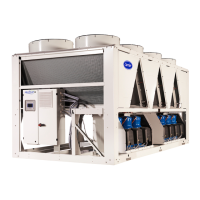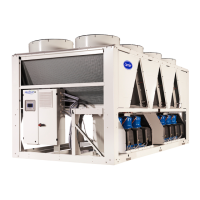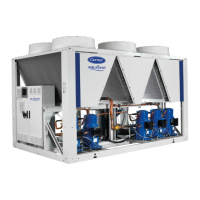7
After the unit has been received, and before it is started up,
it must be inspected for damage. Check that the refrigerant
circuits are intact, especially that no components or pipes have
shifted or been damaged (e.g. following a shock). If in doubt,
carry out a leak tightness check.
Pressure equipment and components
These products include pressure equipment or components
manufactured by the unit manufacturer or by other manufacturers.
We recommend that you contact your professional body to nd
out which regulations affect you as the operator or owner of
pressure equipment or components (declaration, re-qualication,
re-testing, etc.).
The characteristics of this equipment/these components are given
on the name plate or in the regulatory documentation supplied
with the products.
These units comply with the European Pressure Equipment
Directive.
The units are intended to be stored and operated in an environment
where the ambient temperature does not drop below the minimum
allowable temperature indicated on the nameplate.
Do not introduce signicant static or dynamic pressure with regard
to the operating pressures used either during operation or for tests
in the refrigerating circuit or in the heat exchange circuits.
NOTE:
Monitoring during operation, re-qualication, re-testing and
re-testing dispensation:
• Follow
regulations on the monitoring of pressure equipment.
• The user or operator is usually requested to create and
maintain a monitoring and maintenance log.
• In the absence of any regulations, or in addition to the
regulations, follow the guidance in EN 378.
• Follow the local professional recommendations, whenever
they exist.
• Regularly monitor the surface of the components to detect
cavernous corrosion. To do this, check an uninsulated part
of the pressure vessel or at a joint in the insulation.
Regularly check for the presence of any impurities (e.g.
sand, grit) in the heat-transfer uids. These impurities can
cause wear and/or pitting corrosion.
Filter the heat-transfer fluid and carry out internal
inspections as described in EN 378
The reports of the periodical checks by the user or the
operator must be included in the monitoring and
maintenance log.
Repair:
Any repair or modication, including replacement of removable
parts:
• Must comply with local regulations and must be performed
by qualied operators in accordance with qualied processes,
including changing a wiring harness tube,
• Must be approved by the original manufacturer. Repairs and
modications which involve a permanent assembly (welding,
soldering, expansion of tubes, etc.) must be performed by
qualied operators following operating procedures,
• All modications and repairs must be listed in the monitoring
and maintenance register,
• Never attempt to repair or modify a plate heat exchanger.
Recycling:
The pressure equipment can be recycled in whole or in part.
After use they may contain refrigerant vapours and oil residue.
Some parts are painted.
1.4 - Maintenance safety considerations
The manufacturer recommends the following template for the
maintenance log (the table below is only given as a guide and
does not engage the manufacturer's liability).
Applicable national
(1)
(1) Maintenance
Any technician carrying out work on the electrical or
refrigerating section must be authorised, with the relevant
qualifications and certifications, including for soldering
operations and for handling of the shut-off valve. He/she must
have been trained and be familiar with the equipment and the
installation.
The manual valves must only be manipulated when the unit
is off. Do not forget to ret protective caps to prevent leaks.
During any handling, maintenance and service operations the
engineers working on the unit must be equipped with safety
gloves, glasses, shoes and protective clothing.
Never work on a unit that is still energised.
Never work on any of the electrical components until the
general power supply to the unit has been isolated and locked
out.
Even if the unit has been shut down, the power circuit
remains energized, as long as the unit or circuit
disconnect switch is not open. Refer to the wiring
diagram for further details. Follow the appropriate
safety guidelines. When working in a fan area,
specically if the grilles have to be removed, isolate the
power supply to the fans to prevent their operation.
Units equipped with the variable speed fan option, variable
speed pump options and the power factor option are equipped
with capacitor batteries which take 5 minutes to fully discharge
once the power has been switched off.

